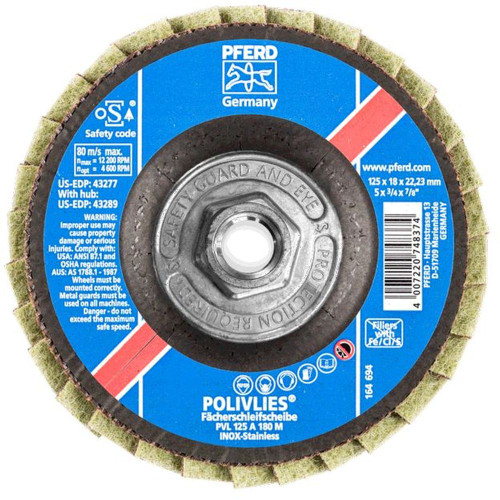All Products On This Page Can Be Purchased From Us Here
Ask Metal Polishing Questions On Our Forum
Download & Print The Complete Booklet - 730 KB
Buffing and polishing using wheels and 'compounds' is somewhat like using wet and dry sanding paper, only much faster. Instead of using 'elbow grease' you will be using the power and speed of an electric motor.
The edge, or face, of the wheel is the 'sanding block', which carries a thin layer of 'compound' which is the sandpaper. Varying types of wheel are available, and the different grades of compound are scaled similar to sandpaper. The compounds are made from a wax substance which has the different abrasive powders added to it. When this hard block is applied to the edge of a spinning buffing wheel, the heat from the friction melts the wax, and both wax and abrasive are applied in a thin slick to the face of the wheel.
The objective of buffing and polishing is to make a rough surface into a smooth one and, of course, each work piece will be in a different condition, so will need different procedures. Imagine the surface magnified thousands of times, it will look like jagged mountains and valleys. By repeated abrasion, you are going to wear down those mountains until they are old, soft, rolling hills! Then they will not dissipate the light, but reflect it. It is the reflection that makes the buffed part appear shiny.
Sand the inside of the part with emery paper. This will show you exactly where the dent is. Using a piece of end grain wood as a block, gently beat out the dent with a hammer.
Offer the jagged blade to the edge of the spinning wheel, and work it across the face until the wheel looks bright and fluffy once more. This action, done periodically, will remove entrapped metal particles, which could scratch a more delicate part.
Swirl marks caused by buffing in the final stages can easily be removed by wetting the part with a damp cloth, then dusting with a powder such as:- Whiting, Talcum Powder or Corn Starch, then buff on your wheel again until the swirls disappear.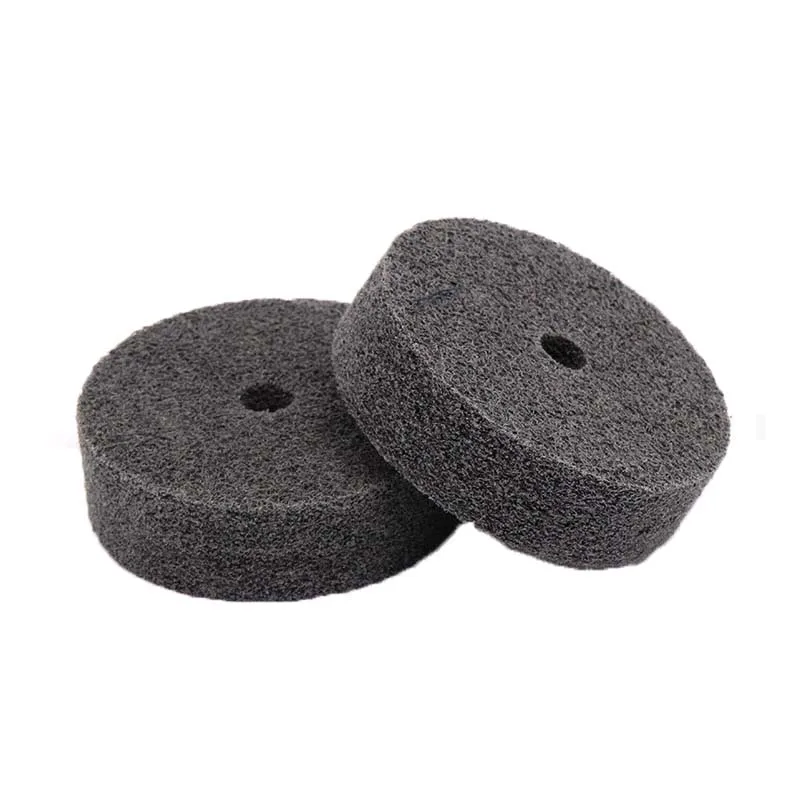
Applying different compounds to the same wheel only causes problems, because you end up with a mixture of abrasive surfaces, and metal deposits left over from the more abrasive operation. These microscopic particles only scratch the surface, destroying any benefit gained by the finer compound. To remove excess compound from the work, apply a small amount of talc to the work and the wheel, then rebuff.
LITTLE & OFTEN is the rule. Too much compound will reduce the effectiveness of the cutting action, because the surface will become TOO greasy and over lubricated. This can often be seen by the prescence of a black slick of compound that seems to reveal around the work piece. Apply compound to the wheel for approx 1 second. Any more is wasted.
CHOOSING THE RIGHT WHEELThere are different types of wheels and these have different effects on the compound they are used with. For example, the SISAL wheel is a coarse 'rope like' fiber, which frays out to make a sort of brush.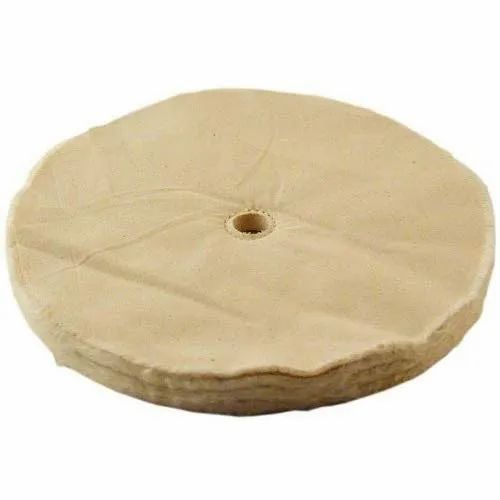 These fibers have a very beneficial effect on scratched and rougher surfaces, almost stroking them smooth. When used with a course 'EMERY' compound, they 'cut' the metal down very rapidly. You could use this compound on a SPIRAL SEWN wheel and it would work, but the job would take much longer because the softer SPIRAL SEWN wheel is not going to thrash the metal so aggressively.
These fibers have a very beneficial effect on scratched and rougher surfaces, almost stroking them smooth. When used with a course 'EMERY' compound, they 'cut' the metal down very rapidly. You could use this compound on a SPIRAL SEWN wheel and it would work, but the job would take much longer because the softer SPIRAL SEWN wheel is not going to thrash the metal so aggressively.
As you progress through the buffing compounds, you will change your buffing wheel, ending up using a soft polishing wheel,such as the CANTON FLANNEL with the least abrasive BLUE or RED compound which only polishes, it has no cutting action.
So, depending on the job in hand, you will determine which abrasive compound and wheel you are going to use first, then step down through the stages until YOU are satisfied with the results. Compounds are made from a mixture of fine abrasive fillers and a sort of greasy wax. The compound is melted, by friction heat, as the bar is pressed to the revolving wheel. This applies a thin layer of abrasive, 'glued' onto the cloth wheel, making it similar to an emery paper, only much faster!
Do not apply the compound after the workpiece, or on its own.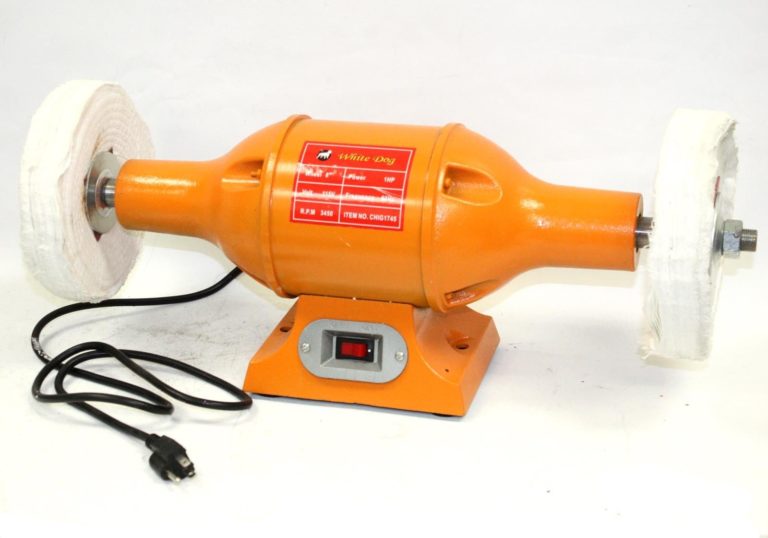 This wastes material and is much less efficient.
This wastes material and is much less efficient.
By applying the material before the workpiece, you actually use the workpiece to force the compound into the buff. This is much less wasteful, more efficient and will actually speed up your buffing times.
| Motor Size | Wheel Diameter | ||||
|
| 4” | 6” | 8” | 10” | 12” |
| 1/6 hp | 1” | 5” | - | - | - |
| 1/4 hp | 1.5” |
1” | 5” | - | - |
| 1/3 hp | 2. | 2” | 1” | - | - |
| 1/2 hp | 3” | 2.5” | 2” | 1” | - |
| 3/4 hp | 4.5” | 3.5” | 2.5” | 2” | 1” |
| 2 hp | 4.5” | 4.5” | 4.5” | 3” | 1.5” |
The table above show the THICKNESS of wheels. You may use multiple wheels to make up total permissible width.
There are two basic buffing motions you should use.
| 1. CUT MOTION gives you:- SMOOTH SURFACE, SEMI-BRIGHT & UNIFORM. The workpiece should be moved AGAINST the direction of the wheel, using a MEDIUM to HARD pressure. 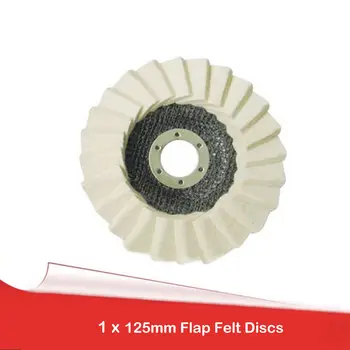 | |
| 2. COLOR MOTION gives you:- BRIGHT, SHINY & CLEAN SURFACE. The workpiece should be moved TOWARD the direction of the wheel, using a MEDIUM to LIGHT pressure. |
The correct pressure must be applied to the workpiece to provide the best finish economically and safely. Inadequate pressure will give NO buffing action.
Excessive pressure will cause the buffing wheel to slow down or actually collapse. This can also result in burn marks on the workpiece.
BUFF RUNNING SPEEDSFor best results your wheel should maintain a surface speed of between 3600 & 7500 Surface Feet Per Minute. (SFPM). The higher your speed, the better and quicker your results.
Formula for calculating surface speed of wheel in SFPM.
SFPM = 1/4 x diameter of Wheel x RPM (revs of spindle per min.)
Therefore an 8” wheel @ 3600 RPM =2 x 3600 = 7200SFPM.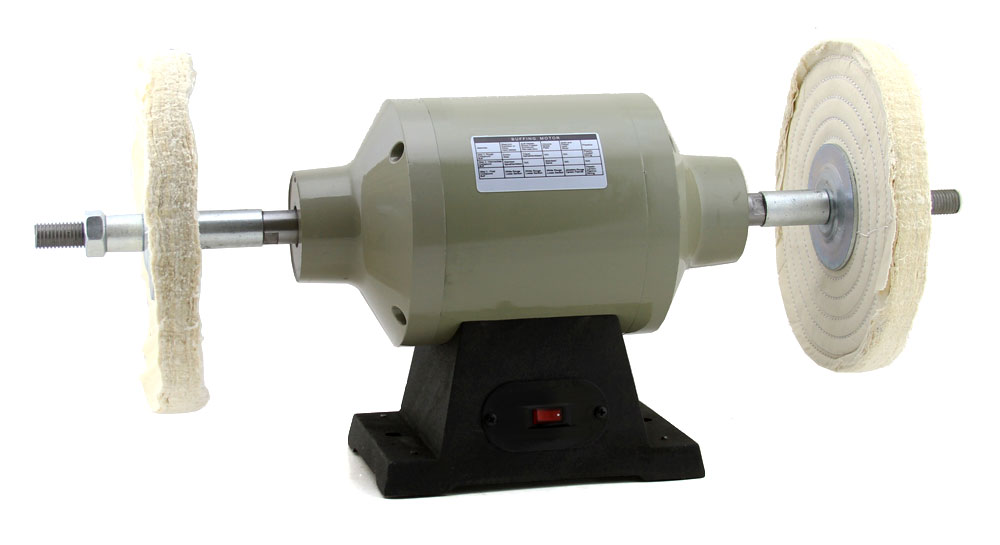 Spindle speeds can be increased by a step pulley on a motor shaft.
Spindle speeds can be increased by a step pulley on a motor shaft.
For the workshop where only the occasional piece of work needs to be buffed, an economic alternative to purchasing a special machine is to simply adapt a bench grinder. Whilst this does not have the extended shaft, it can still do a formidable job.
All the guards need to be taken off and the grinder mounted on the edge of a workbench. This will allow access to the wheel from many angles. Alternatively, a small used washing machine motor can be used. With access to a lathe, a simple pointed taper can be made to fit over the shaft. Then the buffing wheels can be aimed on to the point. On smaller pieces, an electric drill with one of our shank mounted buffs will do an excellent job. Of course, if you want a pre-made, ready to use system, we sell an excellent range of buffing machines.
Some of our customers have even placed a large hand grinder in a vice, then changed the grinding wheel for a buff. These machines usually have very high speeds with good power, so they should be considered as another option.
Whenever you are making up something to do a buffing job, your prime consideration should be your safety.
If the buff pulls the piece from your hands, you should consider where it is likely to go. Remember it will be traveling at a fair speed, so no one should be in its way!
Is the machine mounted safely? It will have to stand a fair amount of abuse, so make sure it is WELL fastened down.
DISCLAIMER - Buffing machines can be dangerous. We accept no liability for their use/misuse or for accidents caused by the removal of guards.
SAFETY FIRSTThere are two distinct areas on a buffing wheel -
THE UNSAFE AREA which is rotating towards the workpiece.
THE SAFE AREA which is rotating away from the workpiece.
The division of these two areas is marked with the dotted line on the above drawings. The workpiece must only be applied to the area of the buff that is rotating AWAY from the workpiece.
You should ensure that you are completely aware which area is which, otherwise you could have a serious accident.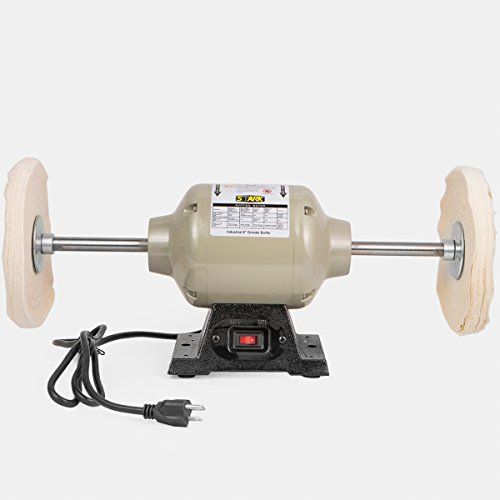 Objects being thrown away from a buffing wheel can be traveling at very high speeds, which can result in some very unpleasant and potentially deadly accidents!
Objects being thrown away from a buffing wheel can be traveling at very high speeds, which can result in some very unpleasant and potentially deadly accidents!
When buffing parts have sharp corners, edges or hooks, they should be offered to the wheel with the edge flowing away from the buff, so the part does not catch. Operators should ALWAYS wear SAFETY GOGGLES, APRON, GLOVES and DUST MASK.
DETERMINING GRIT SIZES of SANDPAPERS and BUFFING COMPOUNDSWe often get asked, 'Which grit should I use first?” Unfortunately, there is no cut and dried answer to this, because it really depends on the condition of the part. So, lets discuss some examples:
1) Aluminum Side Cover with one deep scratch.
To successfully remove the scratch, ALL of the material around the scratch has to be disposed of. In our example, this means a lot of aluminum! Initially, we are concerned with getting as much aluminum sanded off as quickly as possible, so we would use the coarsest abrasive available, say a 40 grit sandpaper on a flat block. It would be of NO USE to try to buff out this deep scratch with a buffing wheel, because the wheel would remove more material from the hole, as well as the surrounding areas. By keeping the abrasive on a flat block, no further material can be removed from the hole.
It would be of NO USE to try to buff out this deep scratch with a buffing wheel, because the wheel would remove more material from the hole, as well as the surrounding areas. By keeping the abrasive on a flat block, no further material can be removed from the hole.
As the scratch is lessened, the grit size of paper is reduced from 40, to 80, 120, 240, 320 and finally 600. Once the surrounding material is removed, then the actual polishing can be started.
Buffing compounds will be determined by the size of the scratches. If you have used a 600 grit paper, you may like to proceed directly to a white buffing compound. If fine scratches are visible, then you'll need to 'back off' and go to the black compound before retrying the white.
2. Aluminum Side Cover - just dull.
Obviously, it would be a step backwards to start treating this piece by using the technique in our first example. As there is no large metal content to be removed, you could virtually dispense with the sandpapers and move directly to the polishing aspect of the part. The Brown buffing compound with a spiral sewn wheel could be employed to see if the shine is good enough. If not, then use a black compound, and then rework the part using the brown compound.
The Brown buffing compound with a spiral sewn wheel could be employed to see if the shine is good enough. If not, then use a black compound, and then rework the part using the brown compound.
3. Aluminum Wheel Casting.
Many wheels are prepainted, directly over a rough sand casting. Remove the paint using a paint stripper, to expose the aluminum. The 'pimples' caused by the sand cast have to be removed to flatten the metal ready for polishing. Because of the difficult contours of the wheel, it is virtually impossible to sand with a flat block, so this is where Greaseless Compound comes in. Start off with the 80 grit, using a spiral sewn wheel or, for the awkward areas, a felt bob. Then proceed through the various grit sizes of Greaseless, until the metal is smooth , all 'pimples' are removed and an even 'flat' finish is achieved. The polishing should only begin once all traces of 'pimples' are gone. Use Black Compound for most of the polishing work, and finally, on a fresh or cleaned wheel, buff lightly with the Brown compound.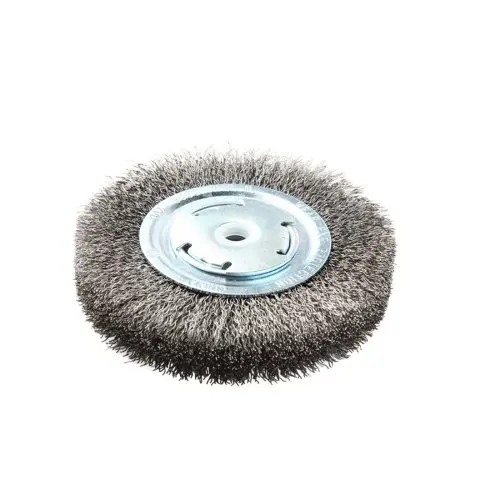
Use this chart to determine which wheels and compounds to use to polish different metals. This is a guide...experienced polishers will vary the materials used to suit the application and their technique. This chart serves as a good starting point for beginning polishers, but feel free to experiment.
BLACK = Emery Compound, a course abrasive material for removal of scratches, pits, paint,
rust etc.
BROWN = Tripoli compound used for general purpose cut and color on most soft metals.
WHITE = Blizzard compound, used for color and final finish of harder metals, has a cutting action.
RED = Jeweller’s Rouge, designed to polish without any cutting action. Safe on thin plates. Use
on its own wheel.
BLUE = A dryer, almost greaseless wheel - designed to polish without any cutting action. Safe
on thin plates. Use on its own wheel.
GREEN = Used exclusively for Stainless Steel.
THE THREE BUFFING STAGES
A = Rough Cut To Remove Scratches
B = Final Cut & Initial Polish - At Stage B, you should first use your wheel with a cutting action, then finish with a color action.
C = Final Polish (or luster)
| THE SISAL BUFFING WHEEL Sisal is a slender, hard, cellular strand of fiber that has demonstrated its great strength and tough resiliency in the form of binder twine, cord & rope for many years. These qualities, along with its natural abrading and grease absorbing characteristics, provide an ideal buffing wheel fabric. Sisal buffing wheels will provide both polishing and cutting action. They will remove stretcher strains, orange peel, polishing wheel grit lines, light die marks, etc. To effect a fast cut, use a sisal wheel with the Black Emery compound or any of the greaseless compounds. | |
| THE SPIRAL SEWN WHEEL Spiral sewn wheels are the workhorse of most buffing and polishing jobs. Because the plies of cotton cloth are sewn together spirally, the wheel becomes much harder and more pressure can be exerted on it. This is especially useful when ‘cutting’ the metal. | |
| THE LOOSE COTTON WHEEL The main purpose of a loose cotton wheel is to polish and cut in a similar manner to the Spiral sewn wheel, except that this wheel, not being tightly stitched together, will ‘mush’ or collapse, allowing the | |
| THE CANTON FLANNEL WHEEL Canton Flannel is a very soft material, and therefore is ideal for polishing items where a gentle touch is needed. Canton Flannel wheels are used in the jewelry trade to polish items with gold or silver plating, where no removal of metal is desired. They can also be used to polish plastic and lacquered items such as guitars. | |
| DOMET FLANNEL WHEEL Domet Flannel is the softest buffing material available. | |
| DENIM BUFFING WHEELS Our newest buffing wheel, the denim buffing wheel, is soft enough for any buffing application that calls for cotton wheels, but, because of the sturdy denim construction, it lasts much, much longer than a cotton buff. The faces of these wheels are pre-raked to accept | |
| TREATED SPIRAL SEWN WHEELS These buffs are specially treated to give longer life than standard buffs. This treatment makes them much harder than regular cotton buffs, which allows the user to exert more pressure onto the wheel and gets the job done faster. Use with any compound just like | |
| CUSHION BUFFS These buffs are sewn with two rows to slightly stiffen the buff.This improves the speed of the final coloring operation, giving you performance somewhere between a spiral sewn and a loose wheel. | |
| TREATED VENTED BUFFS These buffs are specially treated to give longer life than standard buffs. They cut and color faster and are vented to keep the workpiece cooler. Hard center allows fast mounting to tapered spindle for quick change. Use with any compound. | |
| UNTREATED VENTED BUFFS The folded pleats hold more compound and keep the part cooler, resulting in a being twice as fast as a Spiral Sewn wheel. 10” wheels require 3” washers. These wheels are softer than their yellow cousins. | |
| STRING BUFF Thousands of thin cotton string strands will buff all types of plastics, including bacolite, to a shiny surface. The buff is specially designed to keep the plastic cool. Bring side markers, turn signals, tail light lenses to shiny, like new condition. Thousands of 1-3/4” long cotton strands reach deep into details to gently polish and shine without overheating and melting plastic. | |
| THE FINGER BUFF An aggressive wheel, designed to buff irregular contoured metals, especially useful for buffing of checker plate. The treated sewn cloth fingers penetrate into crevices etc. and at the same time reduce friction eat buildup, so reduces the possibility of distorting thin metal panels etc. Use with Greaseless or black emery compounds. The wheel comes with a 5/8” hole in the metal center. ½” inserts are available. | |
| SISAL ROPE BUFF With a thickness of 2”, this long lasting wheel is an economic alternative to stacking sisal wheels on a shaft. The fibers are treated and stiff, giving an excellent hard surface for the initial cut to de-burr etc. Use with Greaseless compounds or Black Emery | |
| MUSHROOM BUFF Diameters are 2. | |
| FACER BUFF Diameters are 2.5, 3.5 & 4.5 inches. | |
| TAPERED BUFF The pointed end is ideal for buffing inside holes and crevices, like the lug nut holes in wheels. Made from soft cotton. Use with any compound. | |
| SCRUBBING MUSHROOM BUFFS Ideal for buffing contoured shapes such as wheels. Scrubber wheels remove rust, scratches, minor blemishes, old paint, and plating. Use a light touch. No compound is required, as the abrasive is already impregnated in the wheel. Gives metal a "satin" appearance. | |
| FLAP WHEELS These tightly packed and bonded sheets of resin bonded aluminum oxide are great for sanding, shaping and polishing all types of materials. | |
| SANDING DRUMS Sanding drums are self expanding rubber spindles with hardened metal arbors and nuts. Precision manufactured to close tolerance, providing smooth and even performance. Use for: sanding, shaping, | |
| ABRASIVE NYLON WHEELS Strands of nylon impregnated with a tough aluminum oxide abrasive. Removes old paint, rust, weld scale and burns. Cleans and polishes. Is ideal for wood because it cleans without gouging. It never loses its abrasive power, or its shape. Safe on | |
| HOURGLASS BUFF™ We developed a special buffing wheel that fits straight into a drill chuck. The unique shape allows the buff to rest on the pipe without spinning off. By simply rotating the drill, all angles of the pipe can be buffed rapidly. The tapered end allows you to get into difficult corners. This buff is ideal for almost any tubing, such as handrails on boats, handlebars, tail pipes etc. Use with almost any buffing compound, but is especially useful with Blue Begone liquid polish. |
There are lots more tips and tricks in our FREE Buffing Booklet. Download The Complete Booklet - 730 KB
In the case of rotating bodies, the "Rate of Rotation" or "Rotational Speed" is the number of revolutions around its own axis per unit of time. For rotating tools, the rate of rotation is usually specified in revolutions per minute (unit: rpm or 1/min).
The Cutting Speed is generally defined as the speed at which the cutting edge of a machining tool is guided through the material. In the case of rotating tools, it corresponds to the peripheral speed. For grinding, cutting and polishing wheels, this is usually given in meters per second (unit: m/s).
The cutting speed of a rotating tool increases both with the speed and with the diameter. The formula for calculating the cutting speed is therefore:
= cutting speed [m/s] = diameter [mm] = rate of rotation [1/min]
[Example: a speed of approx. 3,185 rpm is required for a tool with a diameter of 150 mm to achieve a cutting speed of 25 m/s.]
Using the table below, the cutting speeds can be determined as a function of the diameter and the speeds of the polishing wheels (speeds in rpm, cutting speeds in m/s):
The energy input into the surface of the workpiece and thus the effectiveness of the polishing process is controlled via the cutting speed of the polishing wheel.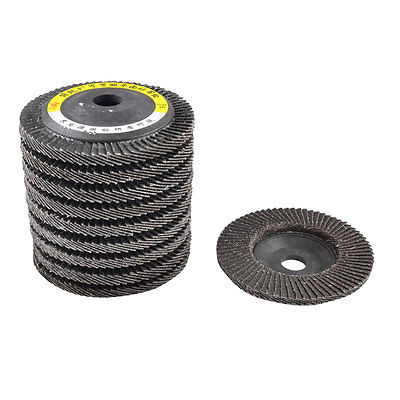 On the one hand, speeds that are too high can lead to overheating of the tool and workpiece. This can result in reduced pad life and surface defects. On the other hand, speeds that are too low are at the expense of effectiveness. It therefore depends to a large extent on the optimal cutting speed whether and how quickly the respective project goal can be achieved.
On the one hand, speeds that are too high can lead to overheating of the tool and workpiece. This can result in reduced pad life and surface defects. On the other hand, speeds that are too low are at the expense of effectiveness. It therefore depends to a large extent on the optimal cutting speed whether and how quickly the respective project goal can be achieved.
The optimum cutting speed depends in particular on the material properties of the workpiece to be machined, the type of tool selected and the specification the polishing pastes used. However, since the determination of optimal process parameters in systematic test series is very complex, the technical know-how of experienced practitioners is to this day the primary source of knowledge when optimizing the polishing process.
As a starting point for your own polishing experiments, please refer to the following table for the typical cutting speeds for different materials and polishing steps. In case if you need assistance, we would be happy to advise you on how to optimize your polishing process. Please send us a message using our contact form and we will get back to you as soon as possible.
Please send us a message using our contact form and we will get back to you as soon as possible.
The maximum cutting speed of a rotating tool is limited by the specific mechanical properties of the tool design. Because above critical cutting speeds there is a risk of tool breakage if, for example, the shearing forces that occur exceed the strengths specific to the tool. However, tools that are operated at too low a speed also pose a risk if they grip workpieces, accelerate to peripheral speed and finally throw them away from the tool.
Therefore, please be sure to observe the safety regulations of your machine manufacturer as well as our safety instructions for system operators.
| A variety of materials are used for polishing, the main of which are: felt; rubber; leather; plastic; paper; sometimes a tree. Basic requirements for materials:
|
| Classification of felt wheels The most popular polishing material is a felt circle made from high quality processed wool.
|
| Felt / special quality / fine wool | semi-coarse; | coarse-haired |
| nine0006 | ||
| Soft felt, made from refined raw materials, is more suitable for polishing glass, marble, non-ferrous metals (aluminum, bronze). | Primary polishing of hard surfaces (stone, metal) can be done with semi-coarse polishing wheels. | For primary grinding or less responsible polishing, or use cheaper coarse wool felt and circles from it. nine0008 |
| It is customary to polish the most important and demanding parts of machines and mechanisms exclusively with fine-wool felt or fine-wool polishing wheels made from it. Working principle with felt wheels The most “comfortable” operating modes are low circumferential speeds, which range from five to ten revolutions per second. If you set higher speeds, then the working surface will be perceived around as harder, which, together with greater centrifugal force, contributes to a faster consumption of material. At the same time, the felt itself breaks away from the circle and the operational period is significantly reduced. Felt wheel cleaning Protection against dust and dirt is a prerequisite for the use of felt wheels. After each polishing, the circle should be removed and wrapped in clean paper. To make it last longer, you should also refrain from using the same wheel with different types of polishing paste. Dirt is usually removed with a piece of pumice stone. Also level the surface of the circle. During the cleaning process, it is advisable to ensure that the pumice particles do not clog inside the felt structure and further contaminate the wheel. Such pieces can cause significant damage to the polished surface in the future. nine0008 |
| This is interesting Since felt has a protein structure based on keratin, it interacts well with the acidic components of the surface being polished. |
| For all purchase questions, please contact sales department: tel./fax: (495) 77-555-66 email email: [email protected] |
Technical felt / Colored felt / Polishing wheels / Parts / Needle punched felt
In Incam they did a big experiment and this is what they found...
The essence of the experiment was to understand at what speed the best performance will be:
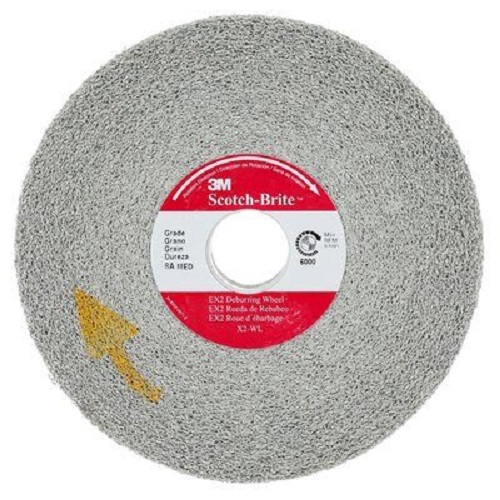
This indicator may differ not only depending on the manufacturer, but even on the batch of machines. nine0048 Often, when visiting the workshops of my friends, I come across the fact that "columns" of the same model, but bought at different times, differ by up to 100 (!) revolutions per minute.
Yes, and in my production I noticed that one polisher working on different machines gives out a different amount of stone for a shift. Machines JuLun 2600, polishes gabbro steles of the same size, on one gives out 19 m2, and on the other 22 m2 per shift.
They began to understand and realized that it was a matter of speed, at the first 825 rpm, at the second 740 rpm. nine0048 It would seem that on a machine with a large number of revolutions, there should be more output ... but no, everything is much more interesting.
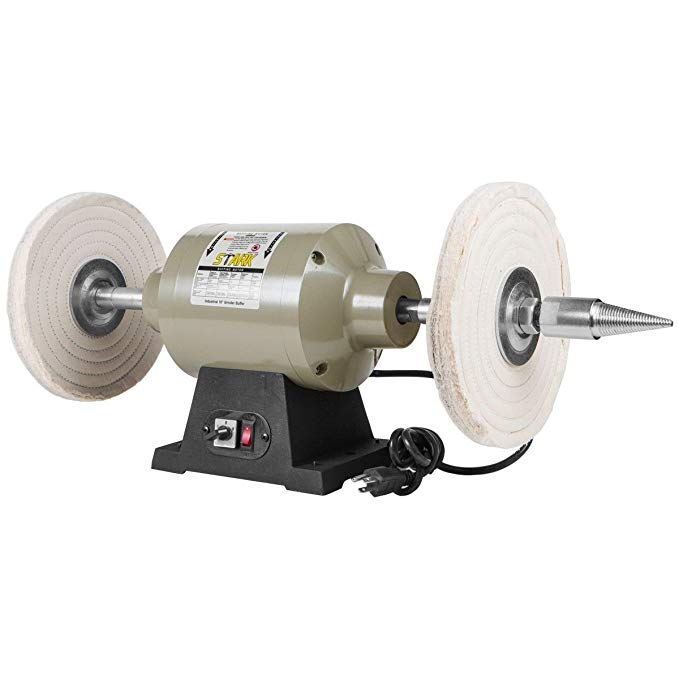
We started by putting a frequency converter on one of the machines. We selected steles of the same size from one block for the experiment and started working at 500 rpm in increments of 50. With the usual circular movements in a spiral, sometimes with gratings.
500 rpm - the Focus tool works surprisingly, but the speed is for "pensioners", you don't need to press hard, the hand feels like the disc is grinding. But Buff (we work with the popular "luxury" 250mm on rubber) heats up for a long time. Time 17:24 min.
550 rpm - not much faster than the previous point, 17:02 min, the effect is the same.
600 rpm - it's getting more interesting, the polishing speed has increased, the time is 15:40 min.
650 rpm - the feeling in the hands becomes like during normal operation, the feeling of disk control disappears. Time 13:37 min. The Buff heats up faster, but still takes a long time to pressurize largely because it takes a long time to heat up and precious minutes are wasted.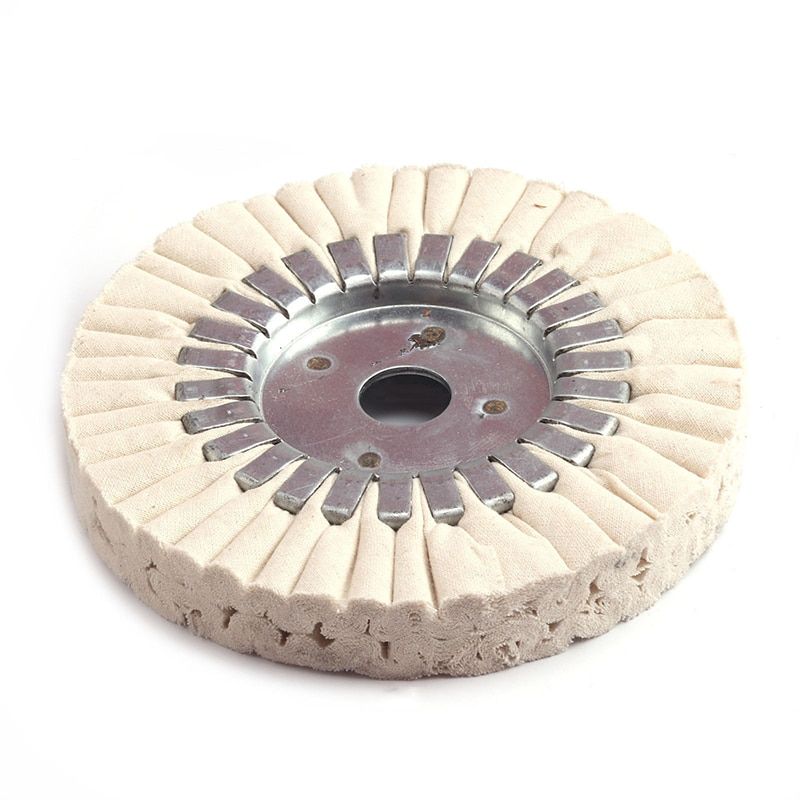
70 0 rpm - it becomes quite interesting and the lux heats up faster, at such speeds you can already work constantly. 12:53
750 rpm - That's it! It is already felt that the tool works by itself, there is practically no need to press, the hands do not strain, and grinding is fast, the time on the stele is 12:14 min. By the way, the buff heats up quickly, there is no need to keep it in one place for a long time. And this reduces the risk that you will burn the stone. nine0008
800 rpm - Also excellent, the time is 12:26, there is practically no difference from 750, apparently this is the very optimal range. You don’t need to press hard - it means that the AShK resource will be maximum, I move quickly, which means the polishing speed is good.
850 rpm - The tool works, but now the Buff has started to hurt, it feels like you need to put more pressure on it. Time 13:43 min.
900 rpm - Tool OK - rustling.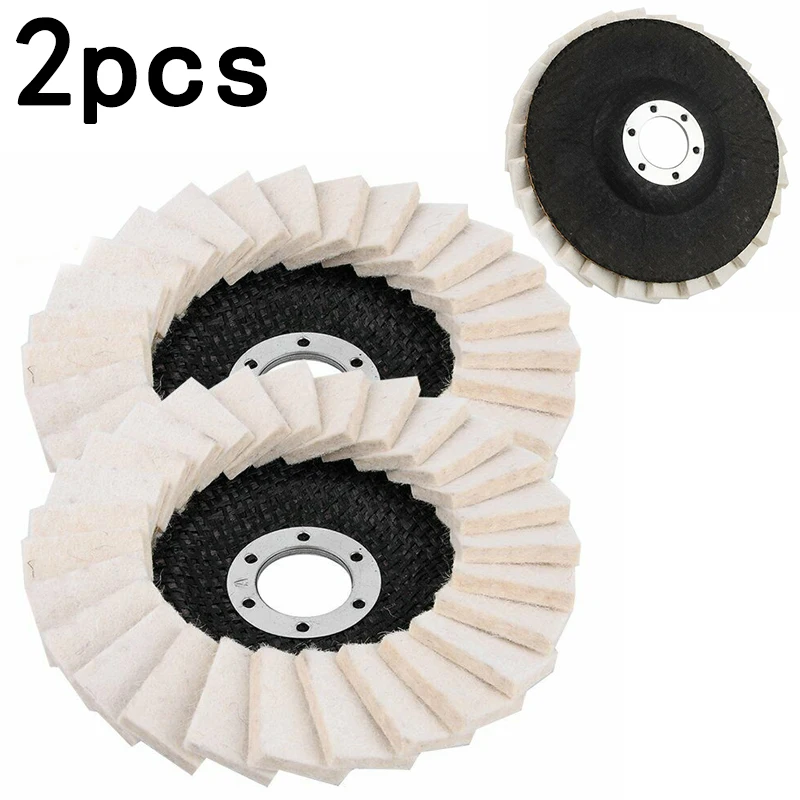 But what I understood with the buff, it began to slide, as it were. This requires more pressure, but the risk of "burning" increases, it will be difficult for a polisher with little experience to strike a balance. Time 14:29min.
But what I understood with the buff, it began to slide, as it were. This requires more pressure, but the risk of "burning" increases, it will be difficult for a polisher with little experience to strike a balance. Time 14:29min.
950 rpm - The tool works, but there is an understanding that it will be erased faster, if you hesitate, you can dig holes. Buff began to slide very strongly, it’s not comfortable to work at such speeds and I don’t want to, perhaps it makes no sense to increase it further. Time 15:12 min.
Revealed optimal revolutions 750 per minute , which will work in our shops. In general, I will recommend from 700 to 800. Maximum polishing speed and tool life. nine0048 Another significant observation is that at these speeds there is no load on the machine itself, the engine runs easily, it does not heat up. From here: Longer machine life + obvious energy savings!
The diamond blades themselves will work at all speeds, but the Buff turned out to be more demanding.